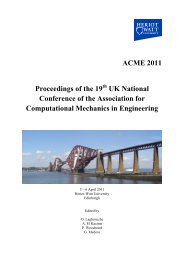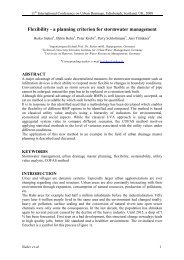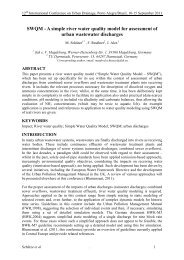PhD Thesis - Automated Recognition of 3D CAD Model Objects in ...
PhD Thesis - Automated Recognition of 3D CAD Model Objects in ...
PhD Thesis - Automated Recognition of 3D CAD Model Objects in ...
Create successful ePaper yourself
Turn your PDF publications into a flip-book with our unique Google optimized e-Paper software.
Literature Review 14<br />
(b<strong>in</strong> size) and sampl<strong>in</strong>g (size <strong>of</strong> the sp<strong>in</strong> image) <strong>of</strong> sp<strong>in</strong> images; (2) sp<strong>in</strong> images have<br />
a low discrim<strong>in</strong>at<strong>in</strong>g capability because they map a <strong>3D</strong> surface to a 2D histogram,<br />
which may lead to ambiguous matches; and (3) although a technique is presented<br />
<strong>in</strong> [64] for accelerat<strong>in</strong>g the match<strong>in</strong>g process, match<strong>in</strong>g is done one-to-one so that<br />
the recognition time grows rapidly with the sizes <strong>of</strong> the model library and <strong>of</strong> the<br />
sensed data. Then, Zhang and Herbert [126] present a technique that uses another<br />
local (po<strong>in</strong>t) surface descriptor, the harmonic shape image. A harmonic shape image<br />
is constructed by mapp<strong>in</strong>g a local <strong>3D</strong> surface patch with disc topology to a 2D<br />
doma<strong>in</strong>. Then, the shape <strong>in</strong>formation <strong>of</strong> the surface (curvature) is encoded <strong>in</strong>to the<br />
2D image. Harmonic shape images conserve surface cont<strong>in</strong>uity <strong>in</strong>formation, while<br />
sp<strong>in</strong> images do not, so that they should be more discrim<strong>in</strong>ative. Additionally, while<br />
the calculation <strong>of</strong> harmonic shape images requires the estimation <strong>of</strong> the size <strong>of</strong> each<br />
image, it does not require the estimation <strong>of</strong> any b<strong>in</strong> size. The recognition process is<br />
then similar to the one use <strong>in</strong> the sp<strong>in</strong> image approach [64]. The results reported on<br />
the performance <strong>of</strong> this technique with respect to occlusions are limited. In particular,<br />
the expected improved performance compared to the sp<strong>in</strong> image approach is not<br />
demonstrated. Additionally, similarly to the sp<strong>in</strong> image approach, this technique<br />
has two ma<strong>in</strong> limitations: (1) harmonic shape images have a limited discrim<strong>in</strong>at<strong>in</strong>g<br />
capability because they map a <strong>3D</strong> surface to a 2D image; and (2) match<strong>in</strong>g is done<br />
one-to-one so that the recognition time <strong>of</strong> this technique grows rapidly with the<br />
sizes <strong>of</strong> the model library and <strong>of</strong> the sensed data.<br />
F<strong>in</strong>ally, Mian et al. [82, 81] have recently presented a technique based on another<br />
local shape descriptor: the <strong>3D</strong> tensor. A <strong>3D</strong> tensor is calculated as follows. A<br />
pair <strong>of</strong> mesh vertices sufficiently far from each other and with sufficiently different<br />
orientations is randomly selected. Then a <strong>3D</strong> grid is <strong>in</strong>tersected with the meshed<br />
data. The pose <strong>of</strong> the grid is calculated based on the paired vertices and their<br />
normals. Each tensor element is then calculated as the surface area <strong>of</strong> <strong>in</strong>tersection<br />
<strong>of</strong> the mesh with each b<strong>in</strong> <strong>of</strong> the grid. The sizes <strong>of</strong> the grid and <strong>of</strong> its b<strong>in</strong>s are<br />
automatically calculated. They respectively determ<strong>in</strong>e the degree <strong>of</strong> locality <strong>of</strong> the<br />
representation and the level <strong>of</strong> granularity at which the surface is represented. The<br />
recognition is performed by simultaneously match<strong>in</strong>g all the tensors from the sensed<br />
data with tensors from the <strong>3D</strong> models. Once an object is identified, its sensed range<br />
po<strong>in</strong>ts are segmented from the orig<strong>in</strong>al data and the process is repeated until no<br />
more objects are recognized <strong>in</strong> the scene. The ma<strong>in</strong> advantage <strong>of</strong> this technique is<br />
that <strong>3D</strong> tensors are local <strong>3D</strong> descriptors, so that they are more discrim<strong>in</strong>ative than<br />
sp<strong>in</strong> images or harmonic shape images. Experiments were performed and an overall<br />
recognition rate <strong>of</strong> 95% is achieved, and the approach can effectively handle up to<br />
82% occlusion. Experimental comparison with the sp<strong>in</strong> image approach also reveal<br />
that this approach is superior <strong>in</strong> terms <strong>of</strong> both accuracy, efficiency and robustness.<br />
However, similarly to the previous ones, this technique has one ma<strong>in</strong> limitation:













